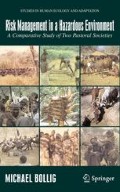Abstract
In this final chapter hazards, risks and risk-minimising strategies will be compared with reference to the two cases studied and to data recorded on other African pastoralists. What is to be gained from such a comparison? The emphasis of this final chapter will be on the causal relations between various hazards, risks and risk minimising strategies. The two cases studied represent a specific type of mobile livestock husbandry that is typical for arid lands in East and Southern Africa. In contrast to pastoral communities in Western and Northern Africa, in the Near and Middle East and in Central Asia, pastoralists in East and Southern Africa were historically peripheral to states or not integrated into states at all. Only during the course of the 20th century did a fuller integration into states occur. Typically, and again in contrast to pastoral communities in other regions of the world, overarching religious systems (such as Islam) were of no major importance. Of course, pastoral communities in Northern Africa and Asia have to cope with similar hazards: drought, degradation and market failures also occur, but the enduring presence of the state and the full-fledged integration into monetarised market systems provide conditions for improved coping mechanisms.
Access this chapter
Tax calculation will be finalised at checkout
Purchases are for personal use only
Preview
Unable to display preview. Download preview PDF.
Endnotes
Douglas North (1987, 1990) described the institutional problems connected to population growth.
Botanical research with the Cologne based ACACIA programme has underlined this observation. Recently Becker & Jürgens (2002) and Schulte (2002) have outlined the sustainability of Himba herding practices from a botanical point of view.
Bourdieu (1979:348) points out that under unstable conditions social and symbolic capital is a more endurable resource than economic capital stored in livestock or grains.
Lindenberg (1998:18) states “emotions have an important role within rational behavior for creating credible commitments”. “Good standing” in a sharing group refers to the history of a member's social history. Solidarity frames are strengthened through mechanisms of building group identity (p.32).
Wiessner & Tumu (1998a, b) give a fascinating account on the intricate interdependencies between production and exchange in the Papua New Guinea highlands. After the introduction of the sweet potatoe households were able to produce sizable surplusses which in turn resulted in the rise of two systems of ceremonial exchange: the Great Wars and the Te exchange. There are ethnographic examples which describe how the pastoralisation or repastoralisation of a group meant an immense increase in productivity. Bonte (1991) gives the example of the pastoralisation of populations in the Zagros Mountains in central Iran, Henrichsen (2000) describes the impact that repastoralisation had on central Namibian economies in the 19th century.
Goldtschmidt (1974:315) described how an increase in pastoral wealth brought about an increase in bridewealth among the Kenya/Ugandan Sebei of Mt. Elgon, a group closely related culturally to the Pokot and hypothesised: “In conformity with economic theory we should expect a gradual secular increase in brideprice and such is clearly shown, both for cattle and for total value of brideprice ... While cattle payments increased gradually throughout this period in the pastoral sector of the Sebei, they levelled off at about six in the farming community.”
Institutionalised livestock loaning to non-relatives is more frequent among highly specialised, wealthy herders than among poor herders and agro-pastoralists (Johnson, 1990; McCabe, 1997). Herren (1991) reports that among the poor Mukogodo herders livestock loaning was virtually unknown. White (1997) reports that livestock loaning was widespread among Wodaabe Fulbe herders in Niger, but since their herds decreased, livestock loans were rare and have been replaced by commercial shepherding arrangements.
In an experimental study on decision making problems within highly cohesive networks, Flache (1996) coined the term “the double edge of networks” and found that, on the one hand, they are conducive to high solidarity, but on the other hand, they are detrimental to the management of communal goods.
There are no archaeological sites with large quantities of cattle bones in south-western Africa, despite a considerable amount of surveying for them (pers. com. A.Smith, University of Cape Town) and a Cologne based archaeology project working in Kaokoland (Vogelsang 2002) did not identify any pastoral sites older than 200 years.
Author information
Authors and Affiliations
Rights and permissions
Copyright information
© 2006 Springer Science+Business Media, Inc.
About this chapter
Cite this chapter
Bollig, M. (2006). Hazards, Risk and Risk Minimisation in African Pastoral Societies. In: Risk Management in a Hazardous Environment. Studies in Human Ecology and Adaptation, vol 2. Springer, Boston, MA. https://doi.org/10.1007/978-0-387-27582-6_7
Download citation
DOI: https://doi.org/10.1007/978-0-387-27582-6_7
Publisher Name: Springer, Boston, MA
Print ISBN: 978-0-387-27581-9
Online ISBN: 978-0-387-27582-6
eBook Packages: Humanities, Social Sciences and LawSocial Sciences (R0)

